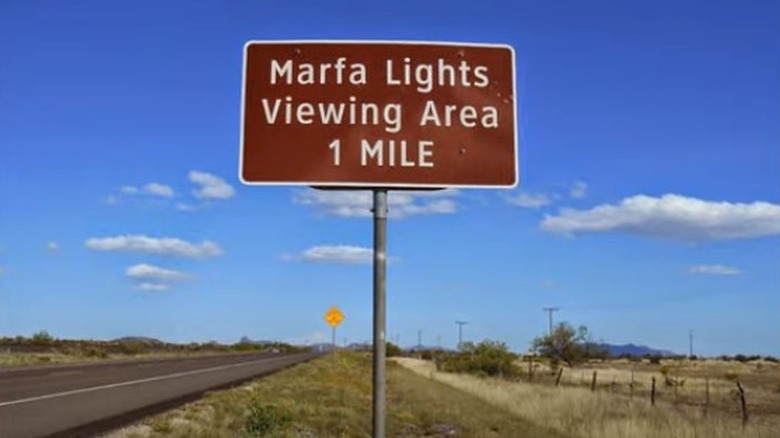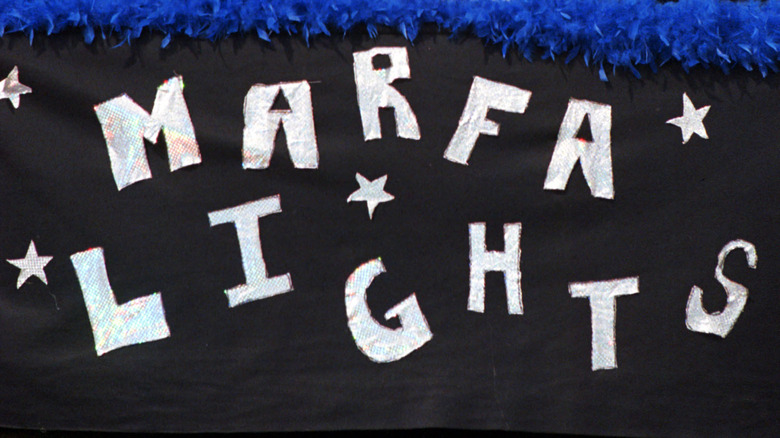What Are The Marfa Lights?
The Marfa lights — also known as "ghost" or "mystery" lights — are a unique phenomenon that occurs off U.S. 90 just outside the town of Marfa, Texas. For almost two centuries, locals and visitors alike have described seeing orbs of light appear on the horizon outside of town — sometimes just flickering, sometimes moving at high speed or in weird patterns against the desert sky (via Visit Marfa).
According to the Texas State Historical Association, the first record of somebody seeing the lights dates back to 1883, when a young cowboy saw them as he was moving cattle. Settlers in the area reported them in 1885, and by 1919, other locals were riding around trying to find the source (often believed to be a campfire). Even more interestingly, reports from around both WWI and WWII mention the lights, with pilots trying to locate them with no luck. Today, nothing much has changed: There's no logical explanation for the lights, and those who travel to Mafra to try and understand them leave just as baffled as they arrived.
What has changed is their popularity — observers from all around the country now arrive in the town, hoping to catch sight of the lights as the sun comes down. The town has even built an official Marfa Lights Viewing Area 9 miles outside town, where drivers can stop by with cameras in hopes of recording the phenomenon.
So what are the lights like?
The lights are unpredictable, but they do seem to be consistent when it comes to certain things. One is size: the lights seem to be about the size of a basketball, according to Live Science. But they aren't always the same color either — although most are white, they can also be red or blue. According to Visit Marfa, the lights have sometimves been described as "whimsical," dancing on the horizon in an almost friendly manner. Although others have described their speed as "frightening." The lights never seem to approach onlookers and disappear as people approach the area where they should be flashing from.
Speaking of area, the space around the town of Marfa is difficult to access, without direct paths or roads. It's also completely uninhabited, which clashes with the most logical explanations, such as the Marfa lights simply being light reflections. Electrostatic discharges, another potential explanation, would not explain the lights' movements or their almost perfectly oval shape (per the Texas State Historical Association).
Because there's no way to predict when the lights will appear (they come in all types of weather, all year long), research has been tricky. According to Texas Monthly, the lights only seem to appear about 30 times a year, so even frequent visitors might miss them.
Theories abound
There are many theories about what the lights could be, some very believable and some a bit "out there." According to Live Science, Native Americans believed the lights were fallen stars, while many today think they could be UFOs and a sign of alien life. There's even a theory making the rounds that the lights are actually the ghosts of conquistadors, forever searching for their lost gold.
A popular theory has always been that the lights are actually weird reflection highlights from vehicles driving on nearby U.S. Highway 67. But this wouldn't explain the older sightings, which happened long before cars were a reality. A potentially more believable explanation could be that the lights are a mirage, a sort of optical illusion caused by very specific atmospheric conditions. Mirages are common in the desert, where the ground is hotter than the air. As light moves through layers of air at different temperatures, it bends, tricking the brain into seeing something that isn't there. In the desert, a common mirage is the illusion of water (per Planet Science). But there's a problem with this theory: mirages are more likely to happen on sunny days, not in the dark like the Marfa lights.
The Marfa lights could also be the desert equivalent of swamp lights, which are produced when certain gases common in swamps ignite and produce temporary flares of light (via Live Science).
No answers
If you thought people would've solved the mystery already if they had taken the phenomenon seriously — well, you'd be wrong. NASA aerospace engineer James Bunnell started investigating the lights in the year 2000 and continued doing so for over a decade. According to his own website, he recorded 288 observations, both on camera (wide spectrum and infrared) and using telescopes.
Since he has a science background, Bunnell set out to study the lights "logically." First, he looked for any sort of movement pattern, but he didn't find any (via the BBC). He then looked at all the obvious theories to see if any of them could explain what he was seeing. His conclusion? You can definitely see car lights reflecting in the desert, and it's very possible that the weather conditions cause some sort of mirage to appear in the distance as well. But he adds that the Marfa lights are neither one of those things — they look completely different and certainly don't move the same way either (via Marfa Public Radio).
Bunnell self-published four books about the lights and confesses he still has no idea what they could be. He joins the ranks of the many who have been fascinated by the lights for a century and still hope to one day figure them out.



